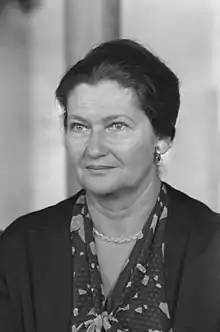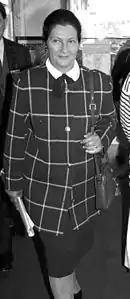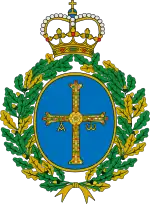Simone Veil
Simone Veil Grand-croix DBE (French: [simɔn vɛj] (![]() listen); née Jacob; 13 July 1927 – 30 June 2017) was a French magistrate and stateswoman who served as Health Minister in several governments and was President of the European Parliament from 1979 to 1982, the first woman to hold that office. As health minister, she is best remembered for advancing women’s legal rights in France, in particular for the 1975 law that legalized abortion, today known as Loi Veil. From 1998 to 2007 she was a member of the Constitutional Council, France’s highest legal authority.
listen); née Jacob; 13 July 1927 – 30 June 2017) was a French magistrate and stateswoman who served as Health Minister in several governments and was President of the European Parliament from 1979 to 1982, the first woman to hold that office. As health minister, she is best remembered for advancing women’s legal rights in France, in particular for the 1975 law that legalized abortion, today known as Loi Veil. From 1998 to 2007 she was a member of the Constitutional Council, France’s highest legal authority.
Simone Veil | |
|---|---|
 | |
| Member of the Constitutional Council | |
| In office 3 March 1998 – 3 March 2007 | |
| Appointed by | René Monory |
| President | Roland Dumas Yves Guéna Pierre Mazeaud |
| Preceded by | Jean Cabannes |
| Succeeded by | Renaud Denoix de Saint Marc |
| Minister for Social Affairs, Health and Urban Issues | |
| In office 30 March 1993 – 11 May 1995 | |
| President | François Mitterrand |
| Prime Minister | Édouard Balladur |
| Deputy | Philippe Douste-Blazy |
| Preceded by | Bernard Kouchner |
| Succeeded by | Élisabeth Hubert |
| President of the European Parliament | |
| In office 17 July 1979 – 18 January 1982 | |
| Preceded by | Emilio Colombo |
| Succeeded by | Piet Dankert |
| Member of the European Parliament for France | |
| In office 17 July 1979 – 30 March 1993 | |
| Preceded by | Constituency established |
| Succeeded by | Jean-Marie Vanlerenberghe |
| Minister of Health | |
| In office 28 May 1974 – 4 July 1979 | |
| President | Valéry Giscard d'Estaing |
| Prime Minister | Jacques Chirac Raymond Barre |
| Preceded by | Michel Poniatowski |
| Succeeded by | Jacques Barrot |
| Personal details | |
| Born | Simone Annie Jacob 13 July 1927 Nice, France |
| Died | 30 June 2017 (aged 89) Paris, France |
| Resting place | Panthéon |
| Political party | UDF (1979)[1] UDF (1995–1997)[2] UDI (2012–2017) |
| Spouse(s) | |
| Children | Pierre François Veil Jean Veil Claude-Nicolas Veil |
| Alma mater | ENM Sciences Po University of Paris |
A Holocaust survivor, of both Auschwitz-Birkenau and Bergen-Belsen, she was a firm believer in the unification of Europe as a way of guaranteeing peace. She served as President of the Fondation pour la Mémoire de la Shoah, from 2000 to 2007, then subsequently as honorary president. Among many honours, she was made an honorary dame in 1998, was elected to the Académie Française in 2008, and received the grand cross of the Légion d’honneur in 2012.
One of France’s most revered figures, Simone Veil and her husband were buried at the Panthéon on 1 July 2018. Her eulogy was given by President Emmanuel Macron.[3]
Early years and family
Simone Jacob was born in Nice in south-east France on 13 July 1927, in an atheist Jewish family. Her father André Jacob was an architect who graduated from Ecole des Beaux-Arts and went on to win the Prix de Rome for Architecture.[4] In 1922 he married Yvonne Steinmetz, she just passed her Baccalaureate and was about to start studying chemistry. André insisted that she abandoned studies upon marriage.[5] The family had moved from Paris to Nice in 1924 hoping to benefit from construction projects on the Côte d’Azur.[5] Simone was the youngest of four siblings, Madeleine (nicknamed Milou) was born in 1923; Denise in 1924 and Jean in 1925.[6] On her father’s side the family had come from Lorraine, on her mother’s from the Rhineland region and from Belgium.[7]
Deportation
When Germany invaded France and the Vichy regime came to power in June 1940, the family managed to avoid being deported as Nice was incorporated in the Italian occupation zone.[8] Asked not come to school, by its superintendent, Simone had to study at home. As the round-up of Jews intensified the whole family split up living with different friends under a false identity. Denise left for Lyon to join the resistance. 16-year-old Simone kept studying and passed her baccalaureate exam under her real name in March 1944.[9] The next day as she was on her way out to meet friends and celebrate the end of secondary school she was arrested by the Gestapo.[9] The same day the rest of the family was also rounded up. Simone, her mother and sisters were sent to the transit camp of Drancy on 7 April 1944 then deported to Auschwitz concentration camp on 13 April in Convoy 71.[4] Simone’s brother and father were deported to the Baltic states in Convoy 73, never to be seen again. Her sister Denise was deported to Ravensbrück concentration camp. Arriving on 15 April 1944 at Auschwitz Simone managed to avoid the gas chamber by lying about her age and was registered for the labour camp.[10] In January 1945 Simone, along with her mother and sisters, was sent on a death march to Bergen-Belsen concentration camp, where her mother died of typhus. Madeleine also fell ill but, like Simone, was saved when the camp was liberated on 15 April 1945.[11]
Back to France
Simone returned to France and started studying law at the University of Paris before going to the Institut d’études politiques, where she met Antoine Veil.[12] The couple married on 26 October 1946, and would go on to have three sons, Jean, Nicolas, and Pierre-François. They moved to Germany where they lived in the American occupied zone.[13] Her sister Madeleine died in a car accident with her son after visiting Simone in Stuttgart in 1952.[14] Simone renounced working as a lawyer and instead passed the national examination to become a magistrate in 1956.[15]
Political career

Ministry of Justice, 1956–1974
After graduating from Institut d'études politiques de Paris with a law degree, Veil spent several years practising law. In 1954, she passed the national examination to become a magistrate.[16] She entered and held a senior position at the National Penitentiary Administration under the Ministry of Justice. She was responsible for judicial affairs and improved women's prison conditions and the treatment of incarcerated women.[17] In 1964, she left to become the director of civil affairs, where she improved French women's general rights and status.[16] She successfully achieved the right to dual parental control of family legal matters and adoptive rights for women.[16] In 1970, she became secretary general of the Supreme Magistracy Council (fr:Conseil supérieur de la magistrature).[17]
Minister of Health, 1974–1979
From 1974 to 1979, Veil was a Minister of Health in the governments of prime ministers Jacques Chirac and Raymond Barre: from 28 May 1974 to 29 March 1977, Minister of Health; from 29 March 1977 to 3 April 1978, Minister of Health and Social Security; and from 3 April 1978 to 4 July 1979, Minister of Health and Family.
She pushed forward two notable laws. The first, passed on 4 December 1974, facilitated access to contraception, the sale of contraceptives such as the combined oral contraceptive pill having been legalized in 1967.
The second, passed on 17 January 1975, legalized abortion in France, her hardest political fight and for which she is best known. The abortion debate was a particularly difficult time as those in favor of keeping abortion illegal launched aggressive personal attacks against Veil and her family.[16] However, since the passing of the law, many have paid tribute to Veil and thanked her for her courageous and determined fight.[16][18]
In 1976, Veil helped to introduce a ban on smoking in certain public places and worked on the problem of medically underserved rural areas.[19]
European Parliament, 1979–1993
In 1979, Veil was elected as a Member of the European Parliament in the first European parliamentary election. In its first session, the new Parliament elected Veil as its first President,[19] a position she held until 1982.[20] The archives concerning her term as President of the European Parliament are deposited at the Historical Archives of the European Union in Florence.[21]
In 1981, Veil won the prestigious Charlemagne Prize an award given to honour the contributions made by individuals to the unity of Europe.[22]
After the end of her term as president, in 1982, she remained a member of the European Parliament. She became Chair of the European Liberal Democrat and Reform Party until 1989. She was re-elected for the last time in the 1989 election, standing down in 1993.[20]
Between 1984 and 1992, she served on the Committee on the Environment, Public Health and Food Safety, and the Committee on Political Affairs. After standing down from these committees, she served on the Committee on Foreign Affairs and its related Subcommittee on Human Rights. Between 1989 and 1993, she was also a member of Parliament's delegation to the ACP-EU Joint Parliamentary Assembly, serving as its vice-chairwoman until 1992.[20]
Return to French Government, 1993–1995
From 31 March 1993 to 16 May 1995, Veil was again a member of the cabinet, serving as Minister of State and Minister of Health, Social Affairs and the city in the government of Prime Minister Édouard Balladur.[23] In the mid-1990s, she worked to help the disabled, HIV-positive patients, and mothers of young children.[19]
Member of the Constitutional Council, 1998
In 1998, she was appointed to the Constitutional Council of France. In 2005, she put herself briefly on leave from the council in order to campaign in favour of the Treaty establishing a Constitution for Europe. This action was criticized because it seemed to contradict the legal provisions that members of the council should keep a distance from partisan politics: the independence and impartiality of the council would be jeopardized, critics said, if members could put themselves "on leave" in order to campaign for a project.[24] In response, Veil said that she, the President of the Constitutional Council and colleagues had deliberated on the issue beforehand and they had given her permission to take her leave without having to resign. Being a staunch supporter of the European project, she believed others should not "ignore the historical dimension of European integration".[24]
Later life and death


In 2003, she was elected to the Board of Directors of the International Criminal Court's Trust Fund for Victims. In 2007, Simone Veil supported presidential candidate Nicolas Sarkozy. She was by his side on the day after he received 31 percent of the vote in the first round of the presidential elections that year.[25]
Simone Veil was the sixth woman to be elected to the Académie française, in 2008. She joined the Academy's forty "immortals", as the members are informally known, occupying the 13th seat, once the seat of literary figure Jean Racine. Her induction address was given in March 2010 by Jean d'Ormesson. On her sword, given to her as to every other immortal, is engraved her Auschwitz number (number 78651), the motto of the French Republic (liberté, égalité, fraternité) and the motto of the European Union, Unity in diversity (Unis dans la diversité).[26]
Veil died at home on 30 June 2017, two weeks before her 90th birthday.[27] Her son Jean said at her public ceremony on 5 July, "I forgive you for having poured water over my head", in reference to an event where she had emptied a carafe of water over his head in disgust at what she considered to be his misogynist remarks.[19]
On 5 July 2017, Veil was honoured with a national ceremony and military honours in les Invalides courtyard,[28] after which she was interred next to her husband, who died in 2013, at Montparnasse Cemetery.[29] The ceremony at les Invalides was attended by President Macron, Holocaust survivors, politicians and dignitaries. In his speech during the ceremony, President Macron announced the decision to rebury Veil and her husband in the Panthéon,[30] which was done on 1 July 2018.[31]
Honours and awards
The following is a list of honours and awards received by Simone Veil.
In 1998 she was awarded as Honorary Dame of the Order of the British Empire (DBE) by the British government.[32]
In 2005 she was awarded the Prince of Asturias Award in International Cooperation.[33]
In 2007 she was awarded the North-South Prize of the Council of Europe.[34]
In 2008 she won the Charles V Prize, awarded by the Fundación Academia Europea de Yuste in honour of "her acknowledged merits in the struggle for the advancement of women's equality."[35]
In 2010 she received the Coudenhove-Kalergi Badge by the Europa-Union Münster.[36]
She was a jury member for the Conflict Prevention Prize awarded every year by the Fondation Chirac.[37]
In 2012 she was appointed a Grand Cross of the Légion d'honneur.[38]
In 2018 she was the subject of a €2 commemorative coin, which design included her deportation registration number, the European Parliament and the year "1975" signifying the legalisation of abortion.[39]
Honorary degrees
- Princeton University (United States), 1975
- Weizmann Institute of Science (Israel), 1976
- Bar-Ilan University (Israel), 1979
- University of Cambridge (England), 1980
- Hebrew University of Jerusalem (Israel), 1980
- Yale University (United States), 1980
- University of Edinburgh (Scotland), 1980
- Georgetown University (Washington, DC, United States), 1981
- University of Urbino (Italy), 1981
- University of Sussex (England), 1982
- Yeshiva University of New York (United States), 1982
- Université libre de Bruxelles (Belgium), 1984
- American University of Paris (France), 1988
- Brandeis University (United States), 1989
- University of Glasgow (Scotland), 1995
- University of Pennsylvania (United States), 1997
- University of Cassino and Southern Lazio (Italy), 2006
- Ben-Gurion University of the Negev (Israel), 2010
The Simone Veil Prize
In 2018, the government of France established a prize in memory of Veil to honour people who fight for women's causes. The intent is to draw attention to efforts in promoting women's autonomy, education, participation in leadership roles, and freedom from violence and discrimination.[40] The prize is awarded each year on 8 March, International Women's Day, with €100,000 to support work in the winner's area of concern. On 8 March 2019, the first Simone Veil Prize was awarded to Aissa Doumara Ngatansou, co-founder of the Association for the Elimination of Violence against Women (ALVF) in Cameroon.[40][41]
Publications
- Veil, S. (2009). Une vie. Ldp Litterature. Stock. ISBN 978-2-253-12776-5.
- Veil, S. (2020). Speeches 2002-2007. Editions Le Manuscrit. ISBN 978-2-304-00423-6.
- Veil, S.; Adler, N.; Nice, G.; Boraine, A. (2004). Genocide and Accountability: Three Public Lectures by Simone Veil, Geoffrey Nice and Alex Boraine. Amsterdam University Press. ISBN 978-90-5629-364-2.
- Veil, S.; Hausser, I. (2010). Une jeunesse au temps de la Shoah: extraits d'Une vie. Litterature & Documents (in French). Librairie générale française. ISBN 978-2-253-12762-8.
- Veil, S. (2004). Les hommes aussi s'en souviennent. Essais - Documents (in French). Stock. ISBN 978-2-234-06831-5.
- Veil, S. (2016). Mes combats. Bayard Culture. ISBN 978-2-227-49020-8.
- Veil, S.; Ormesson, J. (2011). Discours de réception de Simone Veil à l'Académie française. Essais Laffont (in French). Groupe Robert Laffont. ISBN 978-2-221-11738-5.
- Veil, S. (2019). L'Aube à Birkenau (in French). Groupe Margot. ISBN 979-10-375-0108-0.
- Launay, C.; Soulé, M.; Veil, S. (1980). L'adoption: Données médicales, psychologiques et sociales (in French). Les milieux éducatifs de l'enfant. ISBN 978-2-402-22881-7.
References
- Sauvard, J. (2012). Simone Veil - La force de la conviction (in French). L'Archipel. p. 204. ISBN 978-2-8098-0682-3.
- "Le parcours de Simone Veil auprès des Présidents, de Giscard à Sarkozy". BFMTV (in French). 30 June 2017.
- Katz, Brigit. "France's Simone Veil Will Become the Fifth Woman Buried in the Panthéon". Smithsonian. Retrieved 1 July 2018.
- Veil 2007.
- Veil 2007, p. 13.
- Veil 2007, p. 8.
- Veil 2007, p. 10.
- Veil 2007, p. 27.
- Veil 2007, p. 38.
- Veil 2007, p. 51.
- Veil 2007, p. 76.
- Veil 2007, p. 98.
- Veil 2007, p. 110.
- Veil 2007, p. 109.
- Veil 2007, p. 116.
- Hottell, Ruth. "Simone Veil". Jewish Women's Archive. Retrieved 2 July 2014.
- "Simone Veil, défenseuse de l'avortement". L'histoire par les femmes (in French). 14 February 2014. Retrieved 2 July 2014.
- "Simone Veil, French Holocaust survivor who championed women's rights". FRANCE 24. 20 September 2016. Retrieved 21 October 2020.
- Barbara Casassus Obituary Simone Veil. Lancet, Volume 390, No. 10092, p356, 22 July 2017
- "Simone VEIL: History of parliamentary service". Europa.eu. European Parliament. Retrieved 30 January 2017.
- "Cabinet de la Présidence Simone Veil". archives.eui.eu. Retrieved 23 February 2018.
- "Bahrain business pioneer Veil mourned". Trade Arabia. Archived from the original on 7 July 2014. Retrieved 2 July 2014.
- Décret n° 76 du 30 MARS 1993 RELATIF LA COMPOSITION DU GOUVERNEMENT (in French)
- "Référendum : Simone Veil répond à Debré". My TF1 News (in French). Archived from the original on 14 July 2014. Retrieved 30 January 2017.
- Par LEXPRESS.fr avec Reuters et (8 March 2007). "Simone Veil rallie Sarkozy". LExpress.fr (in French).
- Hardach, Sophie (18 March 2010). "Auschwitz survivor Veil joins Academie Francaise". U.K.
- "Simone Veil est décédée à 89 ans". Le Journal du Dimanche (in French). 30 June 2017.
-
- Roe, David (5 July 2017). "France buries women's rights icon Simone Veil". en.rfi.fr.
-
- Breeden, Aurelien (5 July 2017). "Simone Veil to Be Laid to Rest in Panthéon, Among France's Revered". The New York Times. ISSN 0362-4331.
- "Simone Veil". en.gariwo.net. Retrieved 21 October 2020.
- Veil, Simone (1 September 2009). A life. Haus Publishing.
- Intermark, IT. "Simone Veil - Princess of Asturias Awards - The Princess of Asturias Foundation". The Princess of Asturias Foundation.
- "Simone Veil, laureate of the North-South Prize 2007". Committee of Ministers Chairmanships. 13 March 2019.
- S.A., Sarenet (19 June 2008). "King Juan Carlos and Queen Sofía honour Simone Veil. Surinenglish.com". Surinenglish.com, the site for Southern Spain. Latest News . surinenglish.com.
- "Coudenhove-Kalergi-Plakette: Preisträger" [Coudenhove-Kalergi Badge: Recipients]. Europa Union Deutschland, Kreisverband Münster (in German). Retrieved 30 January 2017.
- "The Jury". Fondation Chirac.
- "Simone Veil faite grand'croix de la Légion d'honneur" [Simone Veil made Grand Cross of the Legion of Honour]. Le Parisien (in French). 10 September 2012. Retrieved 9 January 2017.
- "C_2018155EN.01000301.xml". eur-lex.europa.eu.
- "Launch of the Simone Veil Prize of the French Republic". France Diplomatie. 8 March 2019. Retrieved 3 June 2019.
- "Cameroon women's activist wins award in memory of French icon Simone Veil". France24. 8 March 2019. Retrieved 3 June 2019.
External links
 Media related to Simone Veil at Wikimedia Commons
Media related to Simone Veil at Wikimedia Commons
| Political offices | ||
|---|---|---|
| Preceded by Michel Poniatowski |
Minister of Health 1974–1979 |
Succeeded by Michel Poniatowski |
| Preceded by Emilio Colombo |
President of the European Parliament 1979–1982 |
Succeeded by Piet Dankert |
| Preceded by Bernard Kouchner |
Minister of Health 1993–1995 |
Succeeded by Élisabeth Hubert |
| Academic offices | ||
| Preceded by Dries van Agt |
Invocation Speaker of the College of Europe 1980 |
Succeeded by Bruno Kreisky |
| Awards | ||
| Preceded by Emilio Colombo |
Recipient of the Charlemagne Prize 1982 |
Succeeded by Juan Carlos of Spain |
| Preceded by Erasmus Programme |
Recipient of the Prince of Asturias Awards 2005 |
Succeeded by Bill and Melinda Gates Foundation |
| Legal offices | ||
| Preceded by Jean Cabannes |
Member of the Constitutional Council 1998–2007 |
Succeeded by Renaud Denoix de Saint Marc |
| Honorary titles | ||
| Preceded by Pierre Messmer |
Member of the Académie française 2008–2017 |
Vacant |
